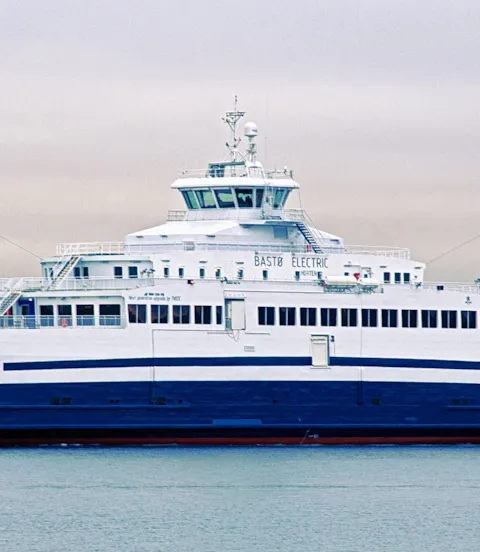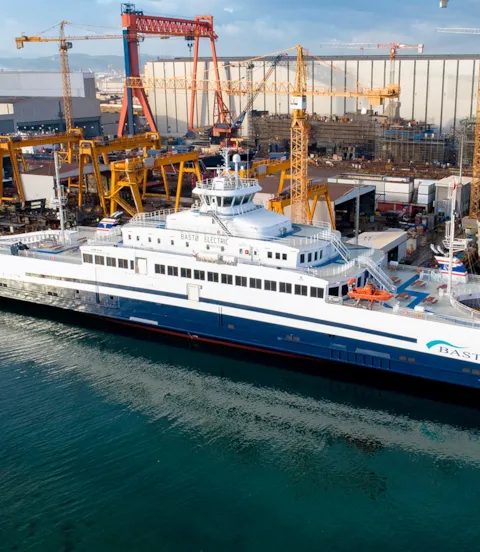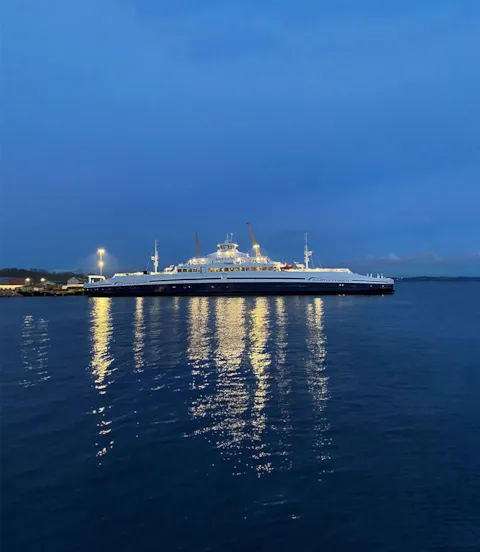Charging into tomorrow today
Bastø Fosen has an electrifying ambition. The shipowner is transforming the fleet of ferries that ply the country’s busiest ferry route to set new standards for clean, efficient and comfortable transportation.
The Bastø Fosen ferries are part of the fabric of life in south-east Norway. The familiar blue and white ships ply the route from the town of Moss to Horten with staggering regularity. Some 36,000 annual departures transport around 1.8 million vehicles and almost 4 million passengers on the 30-minute route, bypassing the traffic of Oslo and connecting the east and west sides of the main Oslo fjord . They are a constant: a symbol of reliability, stability and trust. And now they’re a sign of things to come.

Powering the green shift
In January, Bastø Fosen took delivery of Bastø Electric, the world’s largest all-electric ferry. With capacity for 200 cars, up to 24 heavy goods vehicles and 600 passengers, the 144-metre-long, 20-metre-wide Siemens-powered vessel signifies the start of something truly exciting. Namely, a paradigm shift for the route, the shipowner and, arguably, the wider passenger ship segment in Norway and beyond.
Charging infrastructure – with a fast-loading capacity of 7,200 kW – is currently being completed in both Horten and Moss, but this isn’t just for the Bastø Electric and its 4,000 kWh battery system.

Converting to electric propulsion
Two diesel-powered sister ships are now also being converted to electric propulsion, with the plan of bringing them into operation in 2022. At this point 75% of all departures will be quiet, comfortable and all-electric, saving a massive 6 million litres of diesel out of a total consumption of 8.5 million litres per year.
Bastø Fosen CEO Øyvind Lund is enthused: “We are delighted that we have the opportunity to further electrify Norway’s busiest ferry connection,” he says. “Together with our owners the Torghatten Group we want to be forward-looking, take social responsibility, and really contribute towards the wider green shift in society. We see this development as an important step forward in that process.”

Experts for advanced electric ferries
Bastø Electric is leading that charge. The vessel arrived in Norway after a 20-day voyage from Sefine Shipyard in Turkey. Here DNV operated as a key project partner on the newbuild, with Serhat Bedii Borakan coordinating classification and advisory activities on the ground as project manager. He describes Bastø Electric as a “very special” and technically demanding project, but one well-suited to the local yard infrastructure and competence.
“The shipyards in our region are very specialized with regard to building high-tech vessels for challenging environmental conditions,” Borakan notes. “This has accelerated development, making them a popular destination for advanced newbuilding projects such as this and, with DNV’s leading position in electrification, driving our own growth in the region.”

Maintaining supply chains during the pandemic
However, regardless of expertise, Borakan, who was with the project from inception to delivery, reveals there were challenges. Mainly due to one, all too familiar, culprit. “Covid-19,” he exclaims. “This had a major impact on both the supply chain and the availability of visiting suppliers, with the expectation that there would be major delays.
Thankfully, seamless coordination across the board, from all stakeholders, ensured an excellent team spirit and problem-solving approach. This helped us come together to cope with the challenging circumstances and ensure the minimum of delay. In the end it was an excellent partnership on a truly groundbreaking vessel.”

Taking action for emission-free shipping
Hans Eivind Siewers, Segment Director for Passenger Ships at DNV – Maritime, views Bastø Electric as a significant step on the journey to a more sustainable future in shipping in Norway . He notes that the Scandinavian nation has a well-structured government action plan for green shipping, with a medium-term ambition of reducing emissions from domestic shipping and fisheries by half by 2030. Electricity is a key piece of the puzzle, with the busy ferry segment leading the way. Government figures currently forecast that more than one third of the national car ferry fleet will use electric propulsion systems by 2022.

Technology for electric propulsion is progressing fast
“Developments in this segment are fast-paced,” Siewers explains, “driven by government incentives and forward-thinking shipowners that are well aware of their environmental responsibility. Bastø Electric marks a new milestone in the journey, demonstrating just how quickly technology and ambitions are evolving in the industry.”
The new vessel has four times the battery size and almost double the passenger/vehicle capacity compared to the world’s first all-electric car ferry launched in 2015. “The progression is quite remarkable.”

First on the market with rules for battery propulsion
DNV has been side by side with shipowners every step of the way. Siewers points out that DNV is a “first mover” within this specialist arena, establishing the first industry rules for battery propulsion and working with customers from the outset to enable the safest, most efficient and successful transition to electric propulsion .
“Electricity is central to the decarbonization of the shipping industry,” he opines, “and ferries, with their set routes and relatively short journeys, provide the ideal platform for the introduction and development of technology.”

Partnering for a transition to zero emissions
“We see electric and hybrid vessels as very much ‘here to stay’ and we’re on hand to partner with customers and support their ambitions as they make the transition to zero-emission operations,” says Siewers.
It’s a transition that’s well and truly underway between the two towns of Moss and Horten. Bastø Electric entered service in February, with all charging infrastructure in Horten set for completion in April. Work in Moss should finish in August. Bastø IV and Bastø VI, the two diesel vessels to be converted – Bastø Electric can also operate as a diesel or hybrid, ensuring full flexibility and redundancy – should be all-electric by the end of Q1 2022 .
The fabric of life in south-east Norway is about to get a whole lot cleaner.
Paal Johansen
Global Cruise Ship Director
- Bastø Fosen/Cato Uhlmann
- Sefine Shipyard
- Bastø Fosen